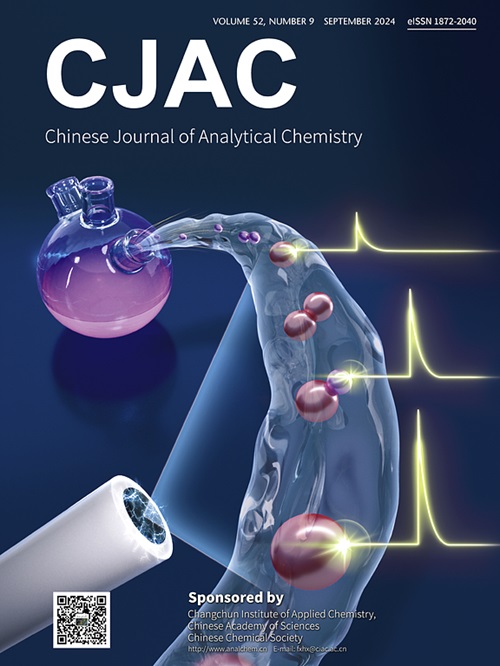利用 UPLC-QTOF-HRMS 测定电子烟液体和气溶胶中的四种烟草特异性亚硝胺
IF 1.2
4区 化学
Q4 CHEMISTRY, ANALYTICAL
引用次数: 0
摘要
阐明商用电子烟中四种烟草特异性亚硝胺(TSNAs)的浓度,分析 TSNAs 与尼古丁之间的相关性,并阐明电子烟中 TSNAs 的主要来源。采用超高效液相色谱-四极杆飞行时间高分辨质谱法(UPLC-QTOF-HRMS)测定了32支市售电子烟中4种TSNA的浓度。结果表明,该方法线性关系良好,质量准确度高。电子烟中四种 TSNAs 的定量限(LOQ)分别为 0.0010 -0.0165 ng-g-1(电子烟液)和 0.0032 -0.0554 ng-g-1(气溶胶)。电子烟中四种 TSNA 的检出限(LOD)分别为 0.0011-0.0165 纳克-20 支-1(电子烟液)和 0.0033-0.0537 纳克-20 支-1(气溶胶)。四种 TSNA 的回收率在 73.06 % 到 109.95 % 之间。电子液体中含有0-33.970(NNN)、0.063-15.654(NNK)、0-10.033(NAT)和 0-0.251(NAB)纳克-克-1。气溶胶中含有0-60.662(NNN)、0.021-9.435(NNK)、0.202-29.866(NAT)和 0-2.841(NAB)纳克-20 微克-1。相关性分析结果表明,电子烟中四种 TSNA 的浓度与尼古丁之间没有明显的相关性。含有烟草提取物的电子烟液中4种TSNAs的浓度明显高于不含烟草提取物的电子烟液,表明TSNAs的主要来源是烟草提取物。该方法快速、简单、灵敏度高、检出限低。该方法可为电子烟的实际监管和安全成分评价提供数据支持,有助于建立有效的质量评价体系。本文章由计算机程序翻译,如有差异,请以英文原文为准。

Determination of four tobacco-specific nitrosamines in electronic cigarette liquids and aerosols by UPLC-QTOF-HRMS
To elucidate the concentrations of four tobacco-specific nitrosamines (TSNAs) in commercial e-cigarettes, analyze the correlation between TSNAs and Nicotine, and clarify the main sources of TSNAs in e-cigarettes. Ultra-high performance liquid chromatography with quadrupole time-of-flight high-resolution mass spectrometry (UPLC-QTOF-HRMS) was employed to determine the concentrations of four TSNAs in thirty-two commercially available e-cigarettes. The results demonstrated that the method exhibits excellent linearity and high mass accuracy. The limits of quantification (LOQ) of four TSNAs in e-cigarettes were 0.0010 –0.0165 (e-liquids) and 0.0032–0.0554 (aerosols) ng·g−1. The limits of detection (LOD) of four TSNAs in e-cigarettes were 0.0011–0.0165 (e-liquids) and 0.0033–0.0537 (aerosols) ng·20 puffs−1. The recovery of four TSNAs ranged from 73.06 % to 109.95 %. The e-liquids contained: 0–33.970 (NNN), 0.063–15.654 (NNK), 0–10.033 (NAT), and 0–0.251 (NAB) ng·g−1. The aerosols contained: 0–60.662 (NNN), 0.021–9.435 (NNK), 0.202– 29.866 (NAT), and 0–2.841 (NAB) ng·20 puffs−1. The correlation analysis results have shown that there was no significant correlation between the concentrations of four TSNAs and nicotine in e-cigarettes. The concentrations of four TSNAs in e-liquid containing tobacco extract were significantly higher than that in e-liquid without tobacco extract, suggested that the main source of TSNAs was tobacco extract. This method is fast, simple, highly sensitive, and has low detection limits. The approach taken can provide data support for the actual supervision of e-cigarettes, and evaluation of safety components, contributing to effective quality evaluation systems.
求助全文
通过发布文献求助,成功后即可免费获取论文全文。
去求助
来源期刊
CiteScore
3.60
自引率
25.00%
发文量
17223
审稿时长
35 days
期刊介绍:
Chinese Journal of Analytical Chemistry(CJAC) is an academic journal of analytical chemistry established in 1972 and sponsored by the Chinese Chemical Society and Changchun Institute of Applied Chemistry, Chinese Academy of Sciences. Its objectives are to report the original scientific research achievements and review the recent development of analytical chemistry in all areas. The journal sets up 5 columns including Research Papers, Research Notes, Experimental Technique and Instrument, Review and Progress and Summary Accounts. The journal published monthly in Chinese language. A detailed abstract, keywords and the titles of figures and tables are provided in English, except column of Summary Accounts. Prof. Wang Erkang, an outstanding analytical chemist, academician of Chinese Academy of Sciences & Third World Academy of Sciences, holds the post of the Editor-in-chief.

 求助内容:
求助内容: 应助结果提醒方式:
应助结果提醒方式:


